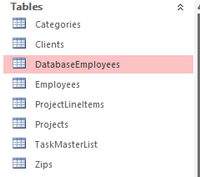
Computer Networking: A Top-Down Approach (7th Edition)
7th Edition
ISBN: 9780133594140
Author: James Kurose, Keith Ross
Publisher: PEARSON
expand_more
expand_more
format_list_bulleted
Question
I need help on this question. It says:
Using Access, open the Relationships window and identify all of the one-to-many relationships in the
Clients.ClientID = Projects.ClientID
Can someone help me?

Transcribed Image Text:The image displays a section of a database management tool showing a list of tables under the heading "Tables." The following tables are listed:
1. **Categories** - Likely used to organize data into different groups or sections.
2. **Clients** - Probably contains information related to clients, such as names, contact details, and other relevant data.
3. **DatabaseEmployees** - This table is highlighted, suggesting it is currently selected. It may store data about employees who manage or interact with the database.
4. **Employees** - Presumably includes information about employees, which could involve personal details, job roles, and employment dates.
5. **ProjectLineItems** - Likely to include details related to specific elements or tasks within a project.
6. **Projects** - Probably stores overarching information about various projects, such as titles, descriptions, and timelines.
7. **TaskMasterList** - May be used to list and manage tasks across different projects or within an organization.
8. **Zips** - Possibly contains data related to postal codes, which could be used for sorting or organizing geographical information.
This setup is typical in database management systems where tables are used to store and organize structured data for easy retrieval and analysis.
Expert Solution
This question has been solved!
Explore an expertly crafted, step-by-step solution for a thorough understanding of key concepts.
This is a popular solution
Trending nowThis is a popular solution!
Step by stepSolved in 3 steps

Knowledge Booster
Similar questions
- In a sql database give an example of a search problem that will work with an inner join and will not work with an outer join. How would you write the query? Why does the search fail or succeed?arrow_forwardDefine the term referential integrity constraint. Give an example of a referential integrity constraint for the tables you created for question 1.8.arrow_forwardGiven the table PRODUCT(ProductID, ProductName, ProductClass, ProductWeight, ProductStyle, ProductColor, ProductPrice). Note: ProductWeight and ProductPrice are numeric fields, and the other attributes are character fields, i.e., store text. Write a SQL query to retrieve all details of products whose name is "Watermelon" and whose color is "green".arrow_forward
- You are working with a database table that contains invoice data. The table includes columns for invoice_id and billing_state. You want to remove duplicate entries for billing state and sort the results by invoice ID. You write the SQL query below. Add a DISTINCT clause that will remove duplicate entries from the billing_state column. NOTE: The three dots (...) indicate where to add the clause. SELECT ... FROM invoice ORDER BY invoice_id What billing state appears in row 17 of your query result? 1 point 1-CA 2-NV 3-WI 4-AZarrow_forwardPlease show all work and write it in PL/SQL and copypaste what you have.arrow_forwardSo what is an example of BOTH correlated and uncorrelated subqueires? Please give simple example for both. Also, could someone briefly explain the concept behind sql triggers? use easy examples.arrow_forward
arrow_back_ios
arrow_forward_ios
Recommended textbooks for you
 Computer Networking: A Top-Down Approach (7th Edi...Computer EngineeringISBN:9780133594140Author:James Kurose, Keith RossPublisher:PEARSON
Computer Networking: A Top-Down Approach (7th Edi...Computer EngineeringISBN:9780133594140Author:James Kurose, Keith RossPublisher:PEARSON Computer Organization and Design MIPS Edition, Fi...Computer EngineeringISBN:9780124077263Author:David A. Patterson, John L. HennessyPublisher:Elsevier Science
Computer Organization and Design MIPS Edition, Fi...Computer EngineeringISBN:9780124077263Author:David A. Patterson, John L. HennessyPublisher:Elsevier Science Network+ Guide to Networks (MindTap Course List)Computer EngineeringISBN:9781337569330Author:Jill West, Tamara Dean, Jean AndrewsPublisher:Cengage Learning
Network+ Guide to Networks (MindTap Course List)Computer EngineeringISBN:9781337569330Author:Jill West, Tamara Dean, Jean AndrewsPublisher:Cengage Learning Concepts of Database ManagementComputer EngineeringISBN:9781337093422Author:Joy L. Starks, Philip J. Pratt, Mary Z. LastPublisher:Cengage Learning
Concepts of Database ManagementComputer EngineeringISBN:9781337093422Author:Joy L. Starks, Philip J. Pratt, Mary Z. LastPublisher:Cengage Learning Prelude to ProgrammingComputer EngineeringISBN:9780133750423Author:VENIT, StewartPublisher:Pearson Education
Prelude to ProgrammingComputer EngineeringISBN:9780133750423Author:VENIT, StewartPublisher:Pearson Education Sc Business Data Communications and Networking, T...Computer EngineeringISBN:9781119368830Author:FITZGERALDPublisher:WILEY
Sc Business Data Communications and Networking, T...Computer EngineeringISBN:9781119368830Author:FITZGERALDPublisher:WILEY

Computer Networking: A Top-Down Approach (7th Edi...
Computer Engineering
ISBN:9780133594140
Author:James Kurose, Keith Ross
Publisher:PEARSON

Computer Organization and Design MIPS Edition, Fi...
Computer Engineering
ISBN:9780124077263
Author:David A. Patterson, John L. Hennessy
Publisher:Elsevier Science

Network+ Guide to Networks (MindTap Course List)
Computer Engineering
ISBN:9781337569330
Author:Jill West, Tamara Dean, Jean Andrews
Publisher:Cengage Learning

Concepts of Database Management
Computer Engineering
ISBN:9781337093422
Author:Joy L. Starks, Philip J. Pratt, Mary Z. Last
Publisher:Cengage Learning

Prelude to Programming
Computer Engineering
ISBN:9780133750423
Author:VENIT, Stewart
Publisher:Pearson Education

Sc Business Data Communications and Networking, T...
Computer Engineering
ISBN:9781119368830
Author:FITZGERALD
Publisher:WILEY